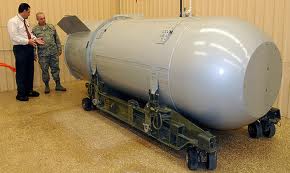US to Finally Scrap Cold War Super Bomb, Ten Years After Retirement
October 19, 2010
Featured Image
Today's top nuclear policy stories, with excerpts in bullet form.
Stories we're following today: Tuesday October 19, 2010.
Story of B-53 'Bunker buster' is a Lesson in Managing Nuclear Weapons - Walter Pincus of The Washington Post [link]
- Outside of the nuclear weapons communities, little notice was paid last week to the announcement that authorization had finally come through to begin dismantling the last of the minivan-size B-53s, the most powerful thermonuclear bombs ever deployed in the active U.S. stockpile.
- A terror weapon if there ever was one, the 10,000-pound B-53 was designed to deliver an explosion of nine megatons. That is the equivalent of 9 million pounds of TNT, or 600 times the power of the bomb that destroyed Hiroshima.
- Why did the United States in the late 1950s and early 1960s need to build more than 300 B-53s? And why were as many as 50 kept through the late 1990s?
- It's a tale that should have lessons for today as the Obama administration considers spending more than $180 billion over the next decade modernizing the nation's nuclear stockpile and replacing the intercontinental ballistic missiles, strategic submarines and aircraft that would deliver them.
- By 1987, there were 25 of the B-53 bombs in the active stockpile. They were considered so dangerous that only dummies were used when crews practiced loading and unloading them on B-52s. It was not until 1997, when the bunker-busting B-61-11s were deployed, that retirement of B-53s began- but not disassembly.
- The current dismantlement program for retired U.S. nuclear weapons has a completion date of 2022 because thousands of them await dismantlement. One cause of the bottleneck is that the Pantex plant is the only NNSA facility that can assemble and dismantle nuclear weapons. More than half of Pantax's tasks involve putting together warheads in the life-extension program so that they can be among the more than 1,000 the United States can keep deployed over the next 20 years.
Scare Tactics - Michael Krepon in Arms Control Wonk [link]
- It’s very hard to mobilize public concern and governmental action without scaring the living bejeezus out of everybody.
- Treaty critics rely heavily on scare tactics to advance their causes. In times of polarity, conviction politics can override substance – especially when blocking action does not require a majority vote. So naysayers borrow scripts developed for the talking heads on Fox, on the assumption that if arguments unsupported by facts are repeated often enough, enough people – in this instance Senators – will believe them to be true.
- What constitutes a smart game plan for treaty backers? One approach is to swallow reservations and agree to spend large sums of money on nuclear programs to alleviate enough concerns in the Senate...for New START, additional resources actually reinforce the objectives and purposes of the treaty: these investments provide confidence in a long-term process of strategic arms reductions.
- Successful arms control is a long haul enterprise. Scare tactics can focus attention and generate support for the short term, but sooner rather than later, this tactic wears off on uncommitted listeners. Besides, the unintended, take-away message of drum-beating nuclear dangers can be to convince listeners of the magnitude and hopelessness of the tasks ahead – when in actuality, extraordinary progress has been made to reduce nuclear dangers over the past two decades.
- Mixed messages are the right messages: Yes, there are very serious nuclear dangers out there, and more is required to tackle these problems. But there’s no reason for despair: the United States and others have made great progress in reducing these dangers since the Cold War ended, and we have the tools to reduce them further, including the occasional treaty.
Russia, U.S. Submit U.N. Resolution on Nuke Tests - Global Security Newswire [link]
- Moscow and Washington on Friday presented at the United Nations a preliminary resolution calling for the prohibition of all nuclear test detonations, among other measures.
- Russian Ambassador to the United Nations Vitaly Churkin voiced the aspiration of the U.N. General Assembly adopting the resolution without dissent. The body's disarmament committee must approve the measure ahead of a floor vote.
- The United States and eight additional "Annex 2" states must still join the Comprehensive Test Ban Treaty before a global ban on nuclear test blasts can enter into force. The other holdouts are China, Egypt, India, Indonesia, Iran, Israel, North Korea and Pakistan.
- The resolution drew from the recent negotiation of a new Russian-U.S. nuclear arms control treaty, according to RIA Novosti.
Create New Markets -- Improve Nebraska's Economy - Senator Ben Nelson (D-NE) in the McCook Daily Gazette [link]
- Early this fall, leaders from about a dozen countries with exotic names like Kazakhstan, Uzbekistan, Turkmenistan, and Tajikistan converged on Nebraska for an important conference that could lead to increased trade with the Cornhusker State which will expand our economy and create jobs.
- Vehicles, machinery, poultry, red meat and other goods are flowing back and forth between our countries, benefitting Americans and Russians every day with $36 billion in total two-way trade during 2008, according to the Office of the United States Trade Representative.
- Eurasia represents a tremendous opportunity for the U.S., not only in trade but in nuclear stability. The Cold War is over but there are still plenty of nuclear missiles in our countries whose numbers need to be reduced. The new START Treaty, which would do just that, is now pending before the Senate.
- It is supported by the current commander at StratCom as well as 7 past commanders and the Secretary of Defense whom I agree with wholeheartedly when he says the world will be safer with the treaty than without it.



